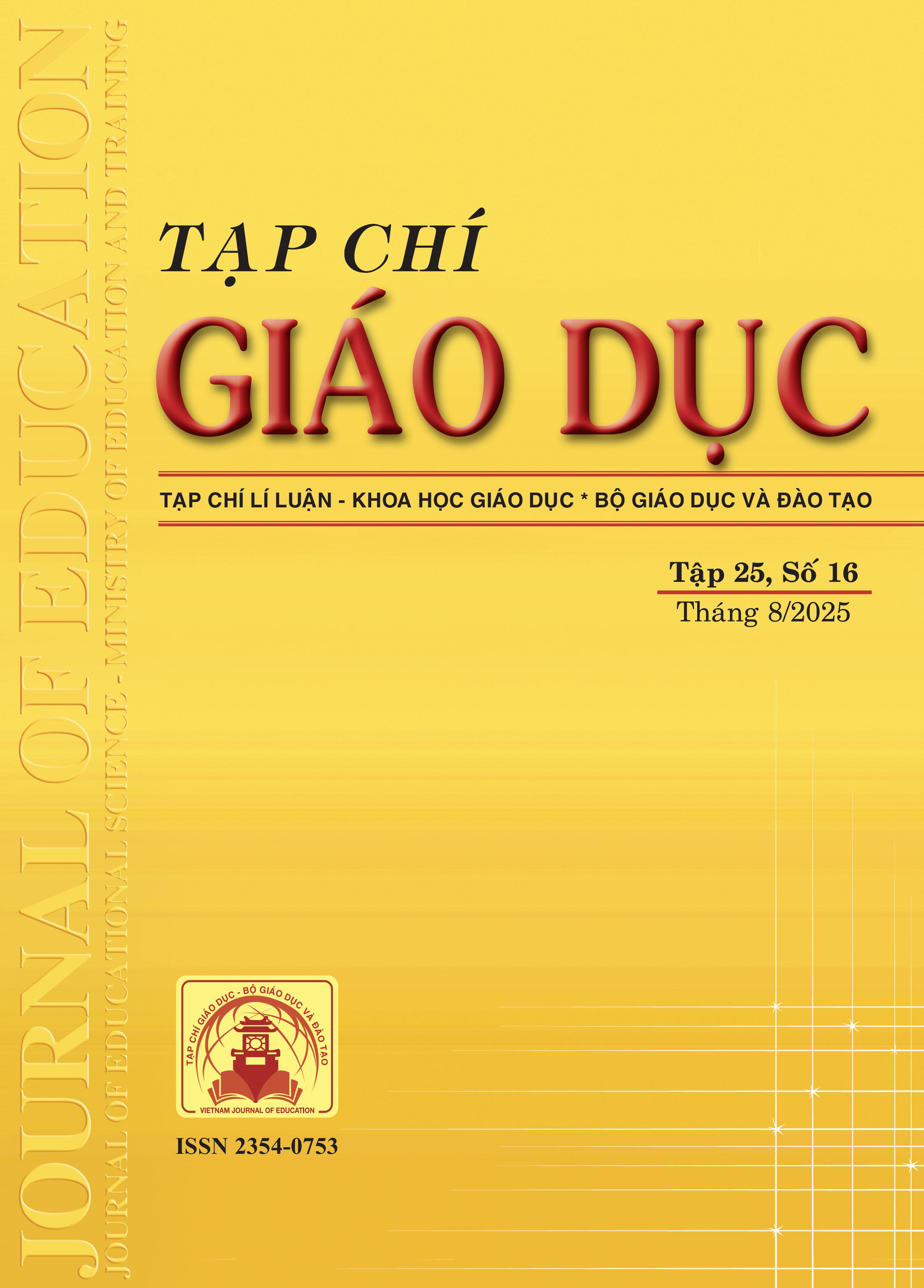Dạy học chủ đề “Nhuộm áo chàm” (Vật lí 11) theo mô hình STEM gắn với bối cảnh xã hội (STEMS)
Tóm tắt
STEM education has become an effective and popular teaching approach in many countries with the aim of helping students solve practical problems based on knowledge of science, technology, engineering and mathematics. The STEMS model - combining STEM with the social context, not only aims to develop scientific capacity but also raise awareness of social responsibility and preserve cultural values for learners. This study develops a teaching process according to the STEMS model and illustrates this process in teaching the topic “Indigo dyeing” (Physics 11) to help students solve practical problems related to local culture and environment. The teaching activities were designed with the integration of scientific theory and practice, creating opportunities for students to develop scientific capacity and understand the value of traditional occupations. The application of the STEMS model aims to help students not only consolidate scientific knowledge but also raise awareness of environmental protection and preservation of local cultural heritage; create a vibrant learning environment and connect students with the community.
Tài liệu tham khảo
Aikenhead, G. S. (2005). Research into STS science education. Educación Química, 16(3), 384-397.
Arshad, A. Y. M. (2021). A systematic review: Issues in implementation of integrated STEM education. Turkish Journal of Computer and Mathematics Education, 12(9), 1124-1133.
Batdi, V., Talan, T., & Semerci, C. (2019). Meta-analytic and meta-thematic analysis of STEM education. International Journal of Education in Mathematics, Science and Technology (IJEMST), 7(4), 382-399.
Bush, S. B. (2019). National reports on STEM education: What are the implications for K-12? In A. Sahin & M. Mohr-Schroeder (Eds.), STEM education 2.0 myths and truths: What has K-12 STEM education research taught us? Brill.
Bybee, R. W. (2013). The Case for STEM Education: Challenges and Opportunities. National Science Teachers Association.
Develaki, M. (2019). Methodology and epistemology of computer simulations and implications for science Education. Journal of Science Education and Technology, 28(4), 1-24.
Diekman, A. B., & Steinberg, M. (2013). Navigating social roles in pursuit of important goals: A communal goal congruity account of STEM pursuits. Social and Personality Psychology Compass, 7, 487-501. https://doi.org/10.1111/spc3.12042
English, L. D. (2016). STEM education K-12: Perspectives on integration. International Journal of STEM Education, 3(3), 1-9. https://doi.org/10.1186/s40594-016-0036-1
Golan, J., & You, J. (2020). Raising aspirations of boys and girls through role models: Evidence from a field experiment. The Journal of Development Studies, 57, 949-979. https://doi.org/10.1080/00220388.2020.1826445
Hán Thị Hương Thủy, Đỗ Hương Trà (2023). Tổ chức dạy học dựa trên vấn đề bài học STEM “Hiện tượng bay hơi và ngưng tụ” (Khoa học tự nhiên 6) nhằm phát triển năng lực khoa học tự nhiên cho học sinh. Tạp chí Giáo dục, 23(13), 29-35.
Holmlund, T. D., Lesseig, K., & Slavit, D. (2018). Making sense of “STEM education” in K-12 contexts. International Journal of STEM Education, 5(32), 1-18. https://doi.org/10.1186/s40594-018-0127-2
Kolb, D. A. (1984). Experiential Learning: Experience as the source of Learning and Development. Englewood Cliffs, New Jersey, Prentice Hall.
MacPhee, D., Farro, S., & Canetto, S. S. (2013). Academic self-efficacy and performance of underrepresented STEM majors: Gender, ethnic, and social class patterns. Analyses of Social Issues and Public Policy, 13(1), 347-369.
Nguyễn Quang Linh, Cao Văn Trung (2024). Thiết kế kế hoạch bài dạy STEM chủ đề “Tương tác từ” trong dạy học kiến thức “Từ trường” (Vật lí 12) nhằm bồi dưỡng năng lực giải quyết vấn đề cho học sinh. Tạp chí Giáo dục, 24(11), 37-41.
Nguyễn Quang Linh, Trần Thị Thu Huệ (2023). Dạy học chủ đề “Năng lượng tái tạo” (Vật lí 11) theo định hướng giáo dục STEMS nhằm phát triển năng lực khoa học cho học sinh. Tạp chí Giáo dục, 23(22), 17-22.
Nguyễn Quang Linh, Vũ Thị Thanh Yến, Dương Văn Tuấn, Nông Minh Ấn (2023). Những năng lực giáo viên cần được bồi dưỡng để triển khai thành công dạy học theo định hướng giáo dục STEM: Nghiên cứu trường hợp tại tỉnh Thái Nguyên. Tạp chí Giáo dục, 23(6), 51-57.
Niekerk, J. V. (2025). Lev Vygotsky. KinderopvangTotaal Op de Groep, 35(1), 10-12. https://doi.org/10.1007/s41189-024-2503-2
Santiago-Delefosse, M. J., & Odéric-Delefosse, J. M. (2002). Spielrein, Piaget and Vygotsky. Three positions on child thought and language. Theory & Psychology, 12(6), 723-747.
Shaffer, D. W., Collier, W., & Ruis, A. R. (2016). A tutorial on epistemic network analysis: Analyzing the structure of connections in cognitive, social, and interaction data. Journal of Learning Analytics, 3(3), 9-45. https://doi.org/10.18608/jla.2016.33.3
Tải xuống
Đã Xuất bản
Cách trích dẫn
Số
Chuyên mục
Giấy phép

Tác phẩm này được cấp phép theo Ghi nhận tác giả của Creative Commons Giấy phép quốc tế 4.0 .












